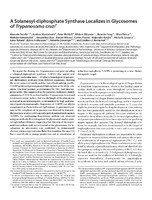Please use this identifier to cite or link to this item:
http://sgc.anlis.gob.ar/handle/123456789/498| DC Field | Value | Language |
|---|---|---|
| dc.contributor.author | Ferella, Marcela | es |
| dc.contributor.author | Montalvetti, Andrea | es |
| dc.contributor.author | Rohloff, Peter | es |
| dc.contributor.author | Miranda, Kildare | es |
| dc.contributor.author | Fang, Jianmin | es |
| dc.contributor.author | Reina, Silvia | es |
| dc.contributor.author | Kawamukai, Makoto | es |
| dc.contributor.author | Bua, Jacqueline | es |
| dc.contributor.author | Nilsson, Daniel | es |
| dc.contributor.author | Pravia, Carlos | es |
| dc.contributor.author | Katzin, Alejandro | es |
| dc.contributor.author | Cassera, Maria B. | es |
| dc.contributor.author | Åslund, Lena | es |
| dc.contributor.author | Andersson, Björn | es |
| dc.contributor.author | Docampo, Roberto | es |
| dc.contributor.author | Bontempi, Esteban | es |
| dc.date.accessioned | 2013-05-22T17:40:40Z | - |
| dc.date.available | 2013-05-22T17:40:40Z | - |
| dc.date.issued | 2006 | - |
| dc.identifier.uri | http://sgc.anlis.gob.ar/handle/123456789/498 | - |
| dc.description | Fil: Ferella, Marcela. ANLIS Dr. C. G. Malbrán. Instituto Nacional de Parasitología "Dr. M. Fatala Chabén" (INP); Argentina. | es |
| dc.description | Fil: Montalvetti, Andrea. University of Illinois. Department of Pathobiology; Estados Unidos. | es |
| dc.description | Fil: Rohloff, Peter. University of Illinois. Department of Pathobiology; Estados Unidos. | es |
| dc.description | Fil: Miranda, Kildare. University of Georgia. Center for Tropical and Emerging Global Diseases. Department of Cellular Biology; Estados Unidos. | es |
| dc.description | Fil: Fang, Jianmin. University of Georgia. Center for Tropical and Emerging Global Diseases. Department of Cellular Biology; Estados Unidos. | es |
| dc.description | Fil: Reina, Silvia. ANLIS Dr. C. G. Malbrán. Instituto Nacional de Parasitología "Dr. M. Fatala Chabén" (INP); Argentina. | es |
| dc.description | Fil: Kawamukai, Makoto. University Matsue. Faculty of Life and Environmental Science. Department of Applied Bioscience and Biotechnology; Japón. | es |
| dc.description | Fil: Bua, Jacqueline. ANLIS Dr. C. G. Malbrán. Instituto Nacional de Parasitología "Dr. M. Fatala Chabén" (INP); Argentina. | es |
| dc.description | Fil: Nilsson, Daniel. Karolinska Institute. Center for Genomics and Bioinformatics; Suecia. | es |
| dc.description | Fil: Pravia, Carlos. ANLIS Dr. C. G. Malbrán. Instituto Nacional de Parasitología "Dr. M. Fatala Chabén" (INP); Argentina. | es |
| dc.description | Fil: Katzin, Alejandro. Universidade de Sao Paulo. Instituto de Ciencias Biomédicas. Departamento de Parasitologia; Brasil. | es |
| dc.description | Fil: Casera, María B. Universidade de Sao Paulo. Instituto de Ciencias Biomédicas. Departamento de Parasitologia; Brasil. | es |
| dc.description | Fil: Áslund, Lena. Uppsala University. Department of Genetics and Pathology; Suecia. | es |
| dc.description | Fil: Andersson, Björn. Karolinska Institute. Center for Genomics and Bioinformatics; Suecia. | es |
| dc.description | Fil: Docampo, Roberto. University of Illinois. Department of Pathobiology; Estados Unidos. | es |
| dc.description | Fil: Bontempi, Esteban. ANLIS Dr. C. G. Malbrán. Instituto Nacional de Parasitología "Dr. M. Fatala Chabén"; Argentina. | es |
| dc.description.abstract | We report the cloning of a Trypanosoma cruzi gene encoding a solanesyl-diphosphate synthase, TcSPPS. The amino acid sequence (molecular mass ∼ 39 kDa) is homologous to polyprenyl-diphosphate synthases from different organisms, showing the seven conserved motifs and the typical hydrophobic profile. TcSPPS preferred geranylgeranyl diphosphate as the allylic substrate. The final product, as determined by TLC, had nine isoprene units. This suggests that the parasite synthesizes mainly ubiquinone-9 (UQ-9), as described for Trypanosoma brucei and Leishmania major. In fact, that was the length of the ubiquinone extracted from epimastigotes, as determined by high-performance liquid chromatography. Expression of TcSPPS was able to complement an Escherichia coli ispB mutant. A punctuated pattern in the cytoplasm of the parasite was detected by immunofluorescence analysis with a specific polyclonal antibody against TcSPPS. An overlapping fluorescence pattern was observed using an antibody directed against the glycosomal marker pyruvate phosphate dikinase, suggesting that this step of the isoprenoid biosynthetic pathway is located in the glycosomes. Co-localization in glycosomes was confirmed by immunogold electron microscopy and subcellular fractionation. Because UQ has a central role in energy production and in reoxidation of reduction equivalents, TcSPPS is promising as a new chemotherapeutic target. | es |
| dc.language.iso | en | es |
| dc.rights | open access | en_US |
| dc.source | The Journal of Biological Chemistry, 2006, 281(51), 39339-39348. | en_US |
| dc.subject | Enfermedad de Chagas | es |
| dc.subject | Trypanosoma brucei | es |
| dc.subject | Leishmania major | es |
| dc.title | A solanesyl-diphosphate synthase localizes in glycosomes of Trypanosoma cruzi | es |
| dc.type | Artículo | es |
| dc.identifier.doi | http://doi.org/10.1074/jbc.M607451200 | - |
| anlis.essnrd | 1 | - |
| item.fulltext | With Fulltext | - |
| item.grantfulltext | open | - |
| item.languageiso639-1 | en | - |
| item.cerifentitytype | Publications | - |
| item.openairetype | Artículo | - |
| item.openairecristype | http://purl.org/coar/resource_type/c_18cf | - |
| Appears in Collections: | Preproducción Publicaciones INP | |
Files in This Item:
| File | Description | Size | Format | |
|---|---|---|---|---|
| TheJournalofBiologicalChemistry,2006,281(51),39339-39348..pdf | 675.51 kB | Adobe PDF |  View/Open |
Page view(s)
153
checked on Dec 16, 2025
Download(s)
43
checked on Dec 16, 2025
Google ScholarTM
Check
Altmetric
Altmetric
Items in DSpace are protected by copyright, with all rights reserved, unless otherwise indicated.

